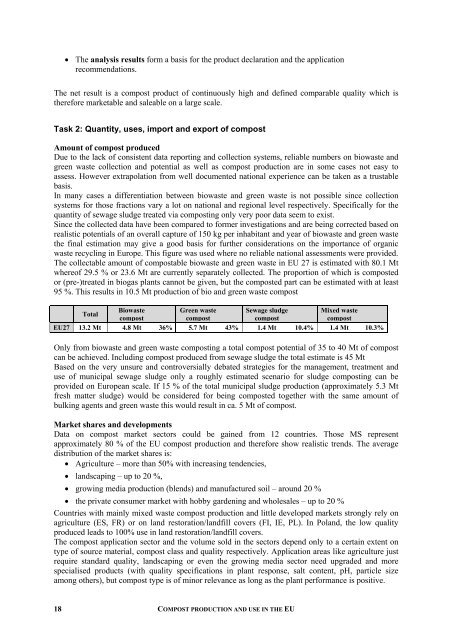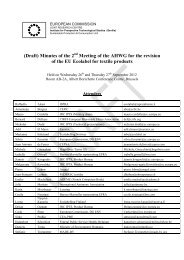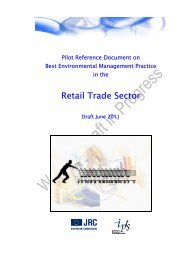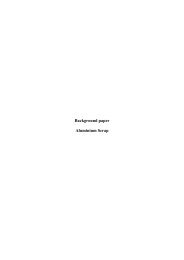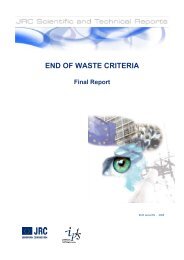final report - JRC IPTS - Sustainable Production and Consumption ...
final report - JRC IPTS - Sustainable Production and Consumption ...
final report - JRC IPTS - Sustainable Production and Consumption ...
Create successful ePaper yourself
Turn your PDF publications into a flip-book with our unique Google optimized e-Paper software.
18<br />
• The analysis results form a basis for the product declaration <strong>and</strong> the application<br />
recommendations.<br />
The net result is a compost product of continuously high <strong>and</strong> defined comparable quality which is<br />
therefore marketable <strong>and</strong> saleable on a large scale.<br />
Task 2: Quantity, uses, import <strong>and</strong> export of compost<br />
Amount of compost produced<br />
Due to the lack of consistent data <strong>report</strong>ing <strong>and</strong> collection systems, reliable numbers on biowaste <strong>and</strong><br />
green waste collection <strong>and</strong> potential as well as compost production are in some cases not easy to<br />
assess. However extrapolation from well documented national experience can be taken as a trustable<br />
basis.<br />
In many cases a differentiation between biowaste <strong>and</strong> green waste is not possible since collection<br />
systems for those fractions vary a lot on national <strong>and</strong> regional level respectively. Specifically for the<br />
quantity of sewage sludge treated via composting only very poor data seem to exist.<br />
Since the collected data have been compared to former investigations <strong>and</strong> are being corrected based on<br />
realistic potentials of an overall capture of 150 kg per inhabitant <strong>and</strong> year of biowaste <strong>and</strong> green waste<br />
the <strong>final</strong> estimation may give a good basis for further considerations on the importance of organic<br />
waste recycling in Europe. This figure was used where no reliable national assessments were provided.<br />
The collectable amount of compostable biowaste <strong>and</strong> green waste in EU 27 is estimated with 80.1 Mt<br />
whereof 29.5 % or 23.6 Mt are currently separately collected. The proportion of which is composted<br />
or (pre-)treated in biogas plants cannot be given, but the composted part can be estimated with at least<br />
95 %. This results in 10.5 Mt production of bio <strong>and</strong> green waste compost<br />
Total<br />
Biowaste<br />
compost<br />
Green waste<br />
compost<br />
Sewage sludge<br />
compost<br />
Mixed waste<br />
compost<br />
EU27 13.2 Mt 4.8 Mt 36% 5.7 Mt 43% 1.4 Mt 10.4% 1.4 Mt 10.3%<br />
Only from biowaste <strong>and</strong> green waste composting a total compost potential of 35 to 40 Mt of compost<br />
can be achieved. Including compost produced from sewage sludge the total estimate is 45 Mt<br />
Based on the very unsure <strong>and</strong> controversially debated strategies for the management, treatment <strong>and</strong><br />
use of municipal sewage sludge only a roughly estimated scenario for sludge composting can be<br />
provided on European scale. If 15 % of the total municipal sludge production (approximately 5.3 Mt<br />
fresh matter sludge) would be considered for being composted together with the same amount of<br />
bulking agents <strong>and</strong> green waste this would result in ca. 5 Mt of compost.<br />
Market shares <strong>and</strong> developments<br />
Data on compost market sectors could be gained from 12 countries. Those MS represent<br />
approximately 80 % of the EU compost production <strong>and</strong> therefore show realistic trends. The average<br />
distribution of the market shares is:<br />
• Agriculture – more than 50% with increasing tendencies,<br />
• l<strong>and</strong>scaping – up to 20 %,<br />
• growing media production (blends) <strong>and</strong> manufactured soil – around 20 %<br />
• the private consumer market with hobby gardening <strong>and</strong> wholesales – up to 20 %<br />
Countries with mainly mixed waste compost production <strong>and</strong> little developed markets strongly rely on<br />
agriculture (ES, FR) or on l<strong>and</strong> restoration/l<strong>and</strong>fill covers (FI, IE, PL). In Pol<strong>and</strong>, the low quality<br />
produced leads to 100% use in l<strong>and</strong> restoration/l<strong>and</strong>fill covers.<br />
The compost application sector <strong>and</strong> the volume sold in the sectors depend only to a certain extent on<br />
type of source material, compost class <strong>and</strong> quality respectively. Application areas like agriculture just<br />
require st<strong>and</strong>ard quality, l<strong>and</strong>scaping or even the growing media sector need upgraded <strong>and</strong> more<br />
specialised products (with quality specifications in plant response, salt content, pH, particle size<br />
among others), but compost type is of minor relevance as long as the plant performance is positive.<br />
COMPOST PRODUCTION AND USE IN THE EU


